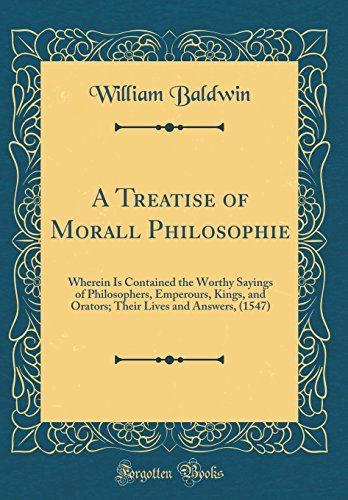
A Treatise of Morall Philosophie Wherein Is Contained the Worthy Sayings of Philosophers, Emperours, Kings, and Orators; Their Lives and Answers, (1547) (Classic Reprint)
Excerpt from A Treatise of Morall Philosophie: Wherein Is Contained the Worthy Sayings of Philosophers, Emperours, Kings, and Orators; Their Lives and Answers, (1547) But possibly we credit Baldwin with too much shrewdness: the 16th century book market, both in Em gland and on the Continent, had an omnivorous appetite for assemblages of proverbs and commonplaces. Erasmus, a shrewder man than Baldwin, had sensed this trend by the penultimate year of the previous century; he produced in 1500 in Paris his first compilation of 818 entries, which he later augmented to 3260 entries in the magnifi cent Venice folio of 1508 entitled Erasmi Roterdamz' Adagiaram Chiliades Tres (the British Museum catalogue lists some 68 variant editions). And everybody borrowed from Erasmus, notably J. Sartorius of Amsterdam (d. Who used a similar title for his compilation (i have only seen the 1670 edition) of 3177 entries. Of course, Erasmus quoted and borrowed too (see the Chicago dissertation of Theodore C. Appelt, and he did not differentiate sharply between classical sen tences and folk sayings (see Harold E. Pagliaro in fmla for March, At any rate this concern with common places, with ethics - or private morals - and with politics - or public morals - was so conspicuous in Elizabethan writing that Roy Battenhouse in his study of Marlowe's Tamhurlaine (1941) was moved to argue that moral philosophy was the dominant intellectual concern of the Elizabethan age (p. 2 Such a view might have offended the sober theologians of Emmanuel College, Cambridge, who could point to the enormous production of theo logical tomes from Tyndale or Jewel or Hooker through the great Puritan writers, Bradshaw, Perkins, or Sibbes. And we must remember that belles lettres, being con cerned with what happens rather than with what hap pened, must always be ultimately proverbial in substance. Yet the problem is almost insoluble: Miss Edith Klotz in her subject analysis of English imprints for every tenth year from 1480 to 1640 (huntington Library Quarterly, I 418 ff), was forced to employ a category of both religion and philosophy since the two subjects could act be separated in any meaningful way. About the Publisher Forgotten Books publishes hundreds of thousands of rare and classic books. Find more at www.forgottenbooks.com This book is a reproduction of an important historical work. Forgotten Books uses state-of-the-art technology to digitally reconstruct the work, preserving the original format whilst repairing imperfections present in the aged copy. In rare cases, an imperfection in the original, such as a blemish or missing page, may be replicated in our edition. We do, however, repair the vast majority of imperfections successfully; any imperfections that remain are intentionally left to preserve the state of such historical works.